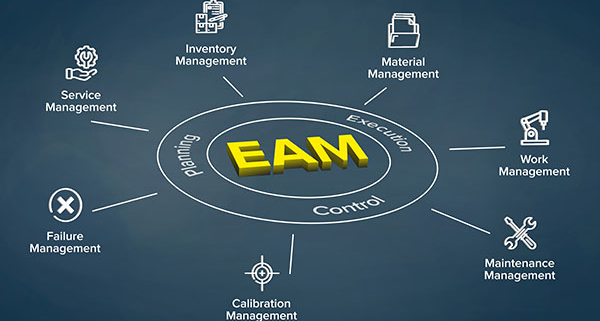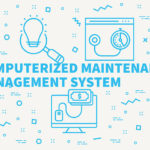What is EAM?
Need a maintenance solution that supports your enterprise needs? The first step in understanding what is EAM software and how it can help you to streamline your asset maintenance strategy.
An enterprise asset management (EAM) combines software, systems, and services to integrate data to optimize the maintenance operations and keep assets operating at their maximum capacities throughout their lifecycles.
Investing in the right EAM system brings multiple benefits to organizations as it decreases asset downtime and reduces the costs associated with reactive maintenance. That increases the efficiency of maintenance teams and makes it easier to organize data. Large organizations that leverage enterprise maintenance management systems tend to a significant increase in operations ROI. Depending on the level of complexity of the organization’s assets, it becomes impossible to manage maintenance without enterprise asset management software.
Let’s get into more details of what maintenance managers must know about EAM:
What is EAM?
Enterprise Asset Management software (EAM) is a platform that allows organizations to effectively generate and organize assets data, and with that, effectively manage their physical assets and infrastructure.
With an EAM, maintenance managers and technicians can easily assess real-time asset data during all phases of the asset lifecycle, which allows for educated decision-making when it comes to optimal machine repair and replacement time.
Assets data is pulled from different sources and departments through built-in sensors, maintenance activity logged in, failure history, and more.
Most EAM providers offer highly customizable solutions, that connect different modules, including work order management, inventory management, spare parts tracking, preventive maintenance management and some even offer predictive maintenance capabilities.
Predictive maintenance capabilities allow enterprises to take a proactive and non-invasive approach to maintenance activities. It leverages the Internet of Things (IoT), big data, and machine learning to collect asset data and form predictive models. Data gathered from machines is analyzed using AI techniques. The information provided helps maintenance teams enhance efficiency, perform corrective maintenance, and maximize investments in their assets.
The ultimate goal of enterprise asset maintenance software is to eliminate manual work that can be automated, improve maintenance professionals’ communication, and support cost-effective managerial decision-making.
The best software options providers offer the system for desktop, tablet, and mobile devices.
Main Functions of an Enterprise Asset Management Software
An effective EAM software performs many key functions, including:
- Reporting and Analytics
- Work Order Management
- Asset Lifecycle Management
- Vendor Management
- Enterprise Resource Planning (ERP)
- Labor Management
- Safety Regulation
- Centralized Database
Difference Between CMMS and EAM
Enterprise asset management software (EAM) is often associated with a computerized maintenance management system (CMMS), but they are not the same.
While a CMMS focuses on maintenance, EAM takes a comprehensive approach to asset management. This means that EAM systems incorporate multiple business functions and departments while CMMS is used mostly by the maintenance team.
A CMMS without enterprise capabilities starts tracking assets after they have been purchased and installed. On the other hand, an EAM system starts asset tracking with design and installation.
EAM is a thorough asset lifecycle management approach that supports asset performance from acquisition to disposal.
Who Benefits from an EAM Software
EAM software is frequently used by organizations that have outgrown their CMMS system. Many CMMS providers, such as Limble CMMS, offer EAM extensions, which makes it easier to transition.
If your organization hasn’t been leveraging a CMMS software yet, and you are trying to decide whether you should start with a CMMS or go straight to an EAM system, think about the number of assets you would need to track, how complex the asset information would be, and ho many different locations and departments would be involved in the process.
It’s likely a good idea to leverage an EAM system if your organization has:
– hundreds of physical assets
– a large team of maintenance professionals
– complex systems and operations across multiple sites
If you have relatively small maintenance operations and need to automate work orders, records, inventory, and spare parts management, then a CMMS without EAM capabilities may be the best solution for you. That’s because a CMMS with the basic functionalities will cost less and will already support your needs.
Some industries that tend to benefit the most from effective operations in the supply chain and maintenance include manufacturing companies, oil & gas organizations, energy companies, fleet management, healthcare companies, food service companies, transportation companies, property management companies, national and state parks, organizations operating in the aerospace, manufacturing companies, hospitality organizations, warehouses, automotive companies, and other types of institutions.
Why is an EAM System Important
Without a powerful system to help maintenance managers assess and organize information, it becomes challenging to understand the best way to organize a maintenance scheduling for each asset. That’s because data is rarely available in these cases. And if it is, it’s not up to date or easy to find.
In a small company’s context, that can already become a huge problem. After all, making wrong decisions regarding when it is the optimal time to perform maintenance can have significant impacts on production and operation costs.
On a larger scale, it is impossible to effectively manage assets without leveraging quality data. Therefore, high-functional asset management is required for asset-intensive organizations that want to succeed. EAM solutions help organizations make the best out of company-wide assets and have greater control over multiple facilities by allowing them to:
- Maintain all asset information in one place. Using a CMMS along with an EAM makes it possible for the maintenance team to access real-time information about any asset, in any location — all from a centralized dashboard. Managers can look at historical data, current operating data, maintenance activities scheduled, and more.
- Prevent machine failure in scale. The best EAM software providers offer preventive maintenance and predictive maintenance modules, which help to keep equipment in a stable operating condition and avoid reactive maintenance.
- Optimize asset usage and extend their life span. EAM software can compile and showcase historical and real-time machinery information through the use of IIoT sensors. This data can be used to dictate how assets are being utilized to extend their reliability, availability, and usable life.
- Integrated assets and connected data. All assets are connected through artificial intelligence (AI), which gives management continuous insight into the current state of all assets. EAM system can aggregate this information and data coming from other departments to make more informed decisions.
- All-in-one software capabilities. While EAM solutions can integrate current applications, many have the capability to combine all maintenance management modules into one system. That establishes a single technology system across the organization, which makes training easier and increases productivity.
Ready to Upgrade Your Asset Management?
If you need a solution that provides a holistic view of your organization’s assets throughout their entire lifecycle, you must look for enterprise asset management software. Modern EAM will provide all the functionalities you need to manage physical assets from design, commission, or procurement, through to operation, maintenance, disposal, and replacement.
At an enterprise-level, it is critical to standardize your maintenance with itemized tasks workflow automation.
If you need further insights on the particularities of an enterprise asset management software solution, how it differs from a standard CMMS software, and how your specific company can benefit from them, book a demo with one of our team members.
At Limble CMMS, we strive to deliver customized solutions based on clients’ needs. For this reason, we have different plans tailored for a variety of company sizes.
Regardless of whether you have few assets or hundreds of assets to manage, you can’t afford to neglect data and automation.




Leave a Reply
Want to join the discussion?Feel free to contribute!